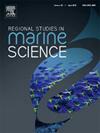Assessment of marine debris and plastic pollution along the western coast of Sri Lanka
IF 2.1
4区 环境科学与生态学
Q3 ECOLOGY
引用次数: 0
Abstract
The accumulation of marine debris along coastal sites is a global issue, yet there is limited knowledge about this problem, particularly in island nations. In this context, the present study focused on assessing the abundance and composition of marine macro debris (>2.5 cm) as well as the abundance and characteristics of plastics along the eight beaches of the western coast of Sri Lanka. Among the macro debris, we found that local-origin, end-consumer products and packaging materials were dominant. Plastic waste was the most abundant macro debris (>50 % of debris) in all sites. Size classification of plastic waste indicated the presence of macro- (>2.5 cm), meso (5 mm–2.5 cm) and microplastics (<5 mm) in all sites where they had spatial differences in abundance. The average macroplastic abundance along the western coast of Sri Lanka was 28.51 particles/100 m². The average meso- and microplastic abundances in this study were 19.83 ± 1.56 and 51.41 ± 1.62 particles/m², respectively. Improper disposal of plastic waste, the MV X-Press Pearl ship accident, proximity to the river mouth, surface ocean currents and wind patterns likely contributed to the spatial variation of marine macro debris and plastic pollution along the western coast of Sri Lanka. Among the studied sites, there was a significant positive correlation (p < 0.05) among the macro-, meso-, and microplastic abundance. This indicates macro-and mesoplastic abundance can be utilized as a proxy for the microplastic abundance along the western coast of Sri Lanka. Macroplastic pollution status calculated by the clean coast index (CCI) classified Crow Island as 'extremely dirty' (CCI>20). Our study highlights the importance of implementing effective waste management systems and raising public awareness on proper waste disposal to manage marine debris pollution along the western coast of Sri Lanka.
评估斯里兰卡西海岸的海洋垃圾和塑料污染
沿海地区海洋垃圾的堆积是一个全球性问题,但人们对这个问题的认识有限,特别是在岛国。在此背景下,本研究的重点是评估斯里兰卡西海岸八个海滩的海洋宏观碎片(>2.5 cm)的丰度和组成,以及塑料的丰度和特征。在宏观碎片中,我们发现本地来源、终端消费产品和包装材料占主导地位。塑料垃圾是所有站点中最丰富的宏观垃圾(> 50% %)。塑料垃圾的尺寸分类表明,所有站点都存在宏观(>2.5 cm),中观(5 mm - 2.5 cm)和微塑料(<5 mm),并且它们的丰度存在空间差异。斯里兰卡西海岸的平均宏观塑料丰度为28.51个颗粒/100 m²。本研究的平均中微塑性丰度分别为19.83 ± 1.56和51.41 ± 1.62颗粒/m²。塑料垃圾处理不当、MV X-Press Pearl船事故、靠近河口、表面洋流和风型可能导致斯里兰卡西海岸海洋宏观垃圾和塑料污染的空间变化。在所研究的位点中,宏观、中观和微观塑料丰度呈显著正相关(p <; 0.05)。这表明宏观和中塑性丰度可以作为斯里兰卡西海岸微塑性丰度的代表。根据清洁海岸指数(CCI)计算的宏观塑料污染状况将克劳岛列为“极度肮脏”(CCI>20)。我们的研究强调了实施有效的废物管理系统和提高公众对妥善处理废物的认识的重要性,以管理斯里兰卡西海岸的海洋垃圾污染。
本文章由计算机程序翻译,如有差异,请以英文原文为准。
求助全文
约1分钟内获得全文
求助全文
来源期刊

Regional Studies in Marine Science
Agricultural and Biological Sciences-Ecology, Evolution, Behavior and Systematics
CiteScore
3.90
自引率
4.80%
发文量
336
审稿时长
69 days
期刊介绍:
REGIONAL STUDIES IN MARINE SCIENCE will publish scientifically sound papers on regional aspects of maritime and marine resources in estuaries, coastal zones, continental shelf, the seas and oceans.
 求助内容:
求助内容: 应助结果提醒方式:
应助结果提醒方式:


